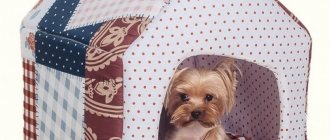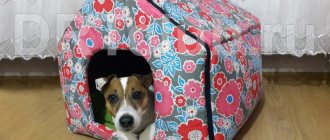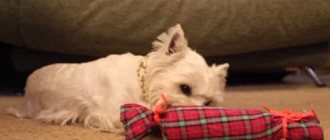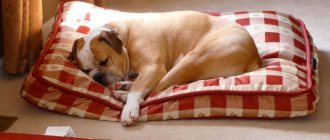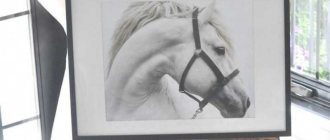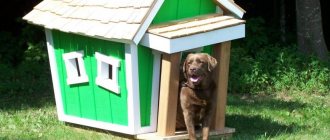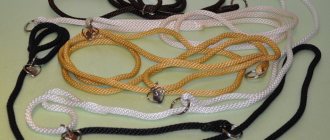Advantages of cardboard
How to make a house for a dog? There are many options for such designs. Houses or loungers are made from a variety of materials. It can be foam rubber, plywood or wood. But one of the most popular options is cardboard. It has a lot of advantages.
Cardboard boxes are often left over after purchasing household appliances. You can purchase a ready-made box at the post office or in specialized stores. This is a cheap material that is easy to process. You can build a variety of structures from it. This could be a simple dog house that is shaped like a cube. But you can also build a whole complex from several elements. The booth can be two-story or consist of several one-story structures. They may differ in shape. But different elements must be made in the same style. For example, they may have round windows or the same decorations.
Processing cardboard is very easy. Even a child can cope with this task. This is an environmentally friendly material that does not release toxic substances into the environment. This is important because dogs have a developed sense of smell. Even the slightest smell of glue, paint or other chemicals can cause discomfort in your four-legged pet.
If the dog is large, it needs a stable kennel. In this case, the cardboard should be thick. For a small dog, a box made of thinner material is suitable. A large selection of cardboard varieties is also its advantage.
Requirements for a dog house
In the introduction to our material, we outlined what houses for animals can be. In short, today we will discuss how to make dog housing for the street and home. Thus, the requirements for housing located inside the apartment are minimal. It should be:
- spacious;
- comfortable for the dog;
- comfortable.
However, with housing for the street it is a little more complicated. The booths that residents of the post-Soviet countries are accustomed to are a real mockery of animals, since they:
- tight;
- blown;
- cold;
- uncomfortable.
A kennel for pets living outside must be insulated and ventilated.
Our task after reading this article will be to create a home with completely opposite characteristics for a street dog:
- ventilated booth;
- warm housing;
- soft and comfortable space;
- spacious home for the dog.
And all this in one bottle. The fact is that living on the street, the dog faces such troubles as wind and frost. The only exceptions are those cases in which the animal lives in a climate zone where the cold seasons are slightly cooler than the warm ones. It turns out that in order to protect the animal from bad weather and the dangerous effects of the environment in general, you need to create a full-fledged home for it.
Interesting fact: some owners equip their pets with real palaces, which are also heated. We do not need to create a multi-room booth, however, today we will talk in particular about how to insulate it.
"Palace" for a dog
Booth size
It is worth noting that houses for small breed dogs differ significantly from designs for large pets. First of all, this product differs in size. If you have a puppy who will grow a lot over time, you shouldn’t immediately make a big house. Your four-legged pet will feel uncomfortable in it. Therefore, first you need to make a small house. Moreover, it is worth making the design only after measuring the size of the animal.
The house for a Chihuahua dog will be very tiny. Its design can be very stylish, modern, or vintage. For large breed dogs, the design of a large home should be substantial, demonstrating the strength and character of the pet.
To make the dog comfortable, the design should not be too small. The dog should lie down comfortably and stretch out to its full length. It is unacceptable for his paws to be bent and rest against the walls of the booth.
To correctly calculate the dimensions of the future structure, you need to measure your four-legged pet. The distance from the floor to the roof of the booth should be 10 cm greater than the height of the dog at the withers. The entrance to the house should be several centimeters wider than the width of the pet’s chest. The length of the kennel should be greater than the size of the dog lying on its side with its paws extended.
So, for example, for large four-legged pets (Great Dane, Caucasian Shepherd Dog), the standard dimensions of the booth are 100x135x95 cm (length, width and height, respectively). A house for a small dog out of a box will be smaller accordingly. The choice of dimensions depends on the size of the animal. These breeds include pug, dachshund, Pekingese and the like. For them, the dimensions of the house are 70x50x60 cm. If the pet is of medium size (boxer, Rottweiler, Shar Pei and others), then the house for him can have dimensions of 115x75x80 cm.
The simplest solution and step-by-step recommendations
A novice home craftsman first needs to visualize the structure he wants to create. For a novice builder, unnecessary imagination usually ends when he starts drawing up a drawing, drawing or sketch.
The product, especially if it is the first, should be planned to be simple, understandable in design, simple rectangular in shape, with a central entrance, single-pitched. First you need to understand that the shape of the booth is an ordinary closed box with a lid.
Drawing of a dog house with dimensions
First the floor is made
- This is a shield with the internal dimensions of the length and width of the booth, but with an addition of 12 cm to the length and width. Four timbers are laid in the shape of a frame on a level table. They can be connected to each other using metal corners.
- On one side, waterproofing is attached to the frame - roofing felt, roofing felt, glassine. There are another dozen or two brand names, but you can choose the cheapest option. You can use a stapler for fastening, you can nail thin slats so that the roofing material does not sag.
- Immediately after filing the insulation, two or three beams are nailed along or across the frame. It is better to paint them or cover them with bitumen mastic - they will stand on the ground, and the coating will save them from rapid rotting.
- The frame is turned over and insulation is placed inside it. You can cover the insulation, if it is glass wool or other dust-producing material, with any insulating film. Next, a continuous plank flooring is made from tongue-and-groove boards 30-40 mm thick.
The next step is to make the side shields
- They are made in the same way as a floor board, but 20 mm thick boards are nailed to the frame, and insulation and insulation are not yet inserted.
- The length of both side panels is equal to the length of the floor, and the width is equal to the internal height of the kennel.
- The sides are installed on the floor flush with its edges and fastened together with screws or corners.
- To perform fastening, it is better to lay the structure on its side.
- The side walls are installed strictly vertically in level and temporarily fixed from above with slats or boards to each other.
Next, the back wall is made
- The manufacturing procedure is the same as for the side ones, and the dimensions should be taken from the already prepared place for the end shield.
- The assembled end wall is inserted into the overall product and attached to the side ones.
Facade part
- The front face has only one additional complication: the manhole structure. The manhole frame is manufactured separately, taking into account the possibility of its insertion into the front wall and fastening to it.
- Subsequently, the front of the booth is sheathed with boards, taking into account the manhole, and installed between the side panels, with the part covered with boards inward, like the previous parts.
Roof
- The last thing to make is the cover - an exact analogue of the floor without insulation.
- It is installed with the sheathed part down and fastened to the side and end walls with self-tapping screws and flat furniture corners.
- On such a structure, the roof slope is determined from the roofing materials used. No slope at all is allowed.
The best option: lay insulation in the roof frame in the same way as the floor, and then cover the top with a sheet of waterproof plywood 12-16mm thick. The size of the covering can be significantly wider and longer than the roof, providing the necessary overhangs, canopies for shade, a rest area for the dog and excellent weather protection for the entire structure.
Side walls
- They can be insulated according to the principle of a roof and ceiling, and then sheathed with plywood or other materials.
Simple booth
To make a dog house from a cardboard box, you will first need to develop a design drawing. Of course, the simplest option is a rectangular booth, which has a pitched or gable roof. The second option looks nicer. The gable roof transforms the box, turning it into a real house.
Regardless of what configuration is chosen for the booth, you first need to develop a drawing. They think through the design down to the smallest detail. In this case, you need to take into account the size of the dog. Draw the entrance, as well as the windows. You can provide a chimney, small shutters, etc. in the house. You should use your imagination. The house should reflect the character of the four-legged pet. You also need to consider whether a cozy nest is being created for a boy or girl dog.
In addition to cardboard, which is purchased in the form of sheets or boxes, you need masking or regular tape, a pattern (created in accordance with the developed drawing) and a sharp stationery knife. You can also use scissors, but they must be of the appropriate size to cut thick material well.
Markings are made with a simple pencil and a ruler. It is best to fasten parts with glue. Regular PVA is suitable for these purposes. But for large houses made of thick cardboard, it is better to purchase liquid nails (transparent varieties).
You need to think about the design of the product. In accordance with the planned plan, a sufficient amount of fabric or wallpaper should be prepared.
Drawings of a winter kennel and a warm enclosure for a dog
Having decided on the dimensions, you should draw a sketch of the booth, observing the following rules:
- make a hole in the long part of the booth, and not in the center, but moving it to any side;
- a gable roof with an attic looks better, but dogs love to lie on the roof, so it is preferable to make a shed roof;
- an insulated but removable roof will allow for regular cleaning of the room;
- In a winter enclosure for a dog, wind protection must be provided;
- you need to install a dog enclosure on a hill, in a place where the dog will have the maximum view of the area;
- The booth must be placed on a platform that prevents flooding with water.
- the floor of the insulated booth should not touch the ground;
- To prevent wind from blowing into the booth, the entrance from the vestibule to the warm room should be made obliquely from the outside.
- Insulation of walls, floors and ceilings must be done conscientiously, “like yourself.”
AlabaevForumHouse Member
I have a frame with 100 mm polystyrene foam without cracks, siding on the outside, 40 mm floorboard on the inside, soft tile roofing.
Here is a drawing of a classic winter booth, on the basis of which many projects of FORUMHOUSE participants have been implemented.
And these are the drawings of an insulated enclosure for an Alaskan Malamute puppy, built by our user with the nickname Sat-Electric.
The walls of the enclosure are sheathed and insulated in the place of the built-in booth
The drawings were made based on the size of the dog with a small margin for the internal partition.
Manufacturing process
To make a dog house with your own hands from a box, you need to use the drawing developed earlier. Each detail is transferred to sheets of paper. Next, they are cut out and transferred to cardboard.
After this, you need to use a sharp stationery knife. With its help, all the details of the future house are cut out. You need to act very carefully so that the edges are even. You can use scissors for these purposes, but only when assembling houses for small breed dogs. Thinner cardboard is suitable for them.
All parts are fastened with tape. If the cardboard is thick and the house is large, it is better to use special glue. This will make the structure durable. Particular attention should be paid to the corners.
Next you need to cover the booth with wallpaper. It is best to choose washable varieties. As they become dirty, you can clean them with a damp cloth. A booth covered with fabric looks impressive. It can be any fluffy textile. The house will immediately become more comfortable and warmer. You can paint the structure with paints.
How to build the right booth. Promised two drawings
We tried to take into account everything described above in two projects. The first option is a single-pitch design without any frills. The second booth is more intricate, but at the same time it takes into account everything mentioned above. The dimensions of the kennel are calculated for a specific dog: according to the principle described at the beginning of the article.
Classic lean-to kennel (scroll right)
Gable hut with covered terrace (scroll right)
A few recommendations
The box box must have additional ventilation. It is best done in the form of small windows. They can have very different shapes. These can be circles, rectangles or other types of geometric shapes. You can make windows in the form of a bone or a bow if you plan to make a house for female dogs. The master's imagination is not limited by anything here. The windows can be covered with mesh fabric or left open.
The house should be cozy not only externally, but also internally. To do this, it is necessary to provide soft flooring. A dog bed can be made from a pillow. Its shape and size must exactly match the dimensions of the booth. You can sew a pillow yourself from foam rubber and soft (preferably fluffy, fleecy) fabric.
Pets really like completely soft kennels. To do this, you need to take a paper pattern that was transferred to cardboard. It is applied to fabric that imitates fur or wool. Cut out individual pieces to finish the cardboard. Seam allowances should be 1.5-2 cm in size. If you plan to place foam rubber between the cardboard and the fabric on the inside, the allowance should be even larger. In this case, the thickness of the foam rubber is taken into account. If, for example, it is 3 cm, the allowance for such a part should be 4.5-5 cm.
The materials are glued using the appropriate composition. Particular attention is paid to seams and corners.
Which technology is optimal?
It is best to build a booth using the frame principle. For these purposes, timber 50x50 mm is optimal. A frame is built from it, which is sheathed on the outside with boards. By the way, pine boards from pallets are excellent for external cladding. They also cover the floor and sheath the roof. The inside walls are covered with thin plywood - you can also use boards, but this will eat up excess internal space. It is advisable to use FK or FB plywood; it is quite waterproof and does not emit toxic phenolic compounds. Read more about the intricacies of choosing plywood here. Again, bothering with the inner lining makes sense if you need a warm booth.
About insulation
The air cavity between the wood and plywood sheathing serves as an excellent heat insulator. For the middle zone it will be more than enough. If you live in regions with harsh winters, you may want to consider additional insulation. To do this, foam plastic or mineral insulation is placed in the wall cavity. In this case, it is also better to insulate the roof. If it is planned to be gable, you can simply make a plywood floor, thus creating something like an attic with an insulating air layer. The kennel should be installed on bricks or raised on logs - this will reduce heat loss, and the kennel itself will not be destroyed by contact with the ground.
Two-story "mansion"
You can make a two-story dog house out of a box with your own hands. This option is especially attractive if a dog and a cat live peacefully in the apartment. To do this, you need to prepare two cardboard boxes. You should also purchase masking or regular tape, a stationery knife and materials for decorating the structure.
In the first and second boxes you need to cut holes for entry. Then they make windows in them. The top box should have a roof, preferably a gable roof. In the bottom box, the sashes are properly glued with tape on both sides. A roof is made in the top box.
Both boxes are firmly attached to each other using glue. Particular attention is also paid to corners and joints.
Once the glue has dried, you can begin decorating the house. It can be made completely soft, but you can get by with just fluffy dog and cat beds. The outer part is covered with wallpaper or fabric. Windows can be highlighted by finishing them with bright braid. Cover the roof with a different material, highlighting it in the structure.
You can also make a soft version of this house. To do this, even at the preparation stage, the internal space of the blanks is covered with foam rubber. A soft cloth with long pile is applied to it. After this, all parts of the structure are assembled together.
Houses for apartment dogs
Before we move on to discussing how to build a good-quality doghouse, let’s start making houses for dogs living in apartments. By the way, they don’t have to be small, because the animal’s growth is not at all an obstacle to building a comfortable resting place for it. As you begin building your dream dog house, check out the following interesting tips from experienced dog owners who have built houses for their own pets many times over.
So, in order to make a soft mattress for a dog, it is best to cover the floor of a manufactured home kennel not with polystyrene foam, but with polyurethane foam. This material, like an expensive orthopedic mattress, remembers the contours of the dog’s body. Agree, it is much more comfortable to sleep on such a “smart” surface; your dog will certainly appreciate it.
Polyurethane foam
It is better to make the walls of the house as thick as possible, while all their corners should be hidden under fabric, since dogs, especially at a young age, love to chew all materials that are suitable for the walls of the house:
- Styrofoam;
- hard sponges;
- cardboard;
- thin plywood, etc.
Foam panels are perfect for an apartment dog house
Not only will the product completely lose its appearance when the house is torn apart, but your pet also gets the opportunity to:
- accumulate harmful materials;
- get hurt on sharp corners.
When calculating the size of your puppy's future home, think about the fact that the baby will soon become an adult. If the pet does not belong to the toy and dwarf varieties of any breed, it is necessary to make the home much larger in size than the dog is now, that is, such that, for example, your mature St. Bernard can not only lie down comfortably inside the house, but also:
- stand up to your full height;
- turn around its axis.
The house must be the right size for the dog
If you want your dog to be comfortable inside the house for a long time, strictly prohibit children from playing with the house. Firstly, because it is the property of your pet, and secondly, while the child sits on the house, the dog may be inside, as a result the animal can:
- get injured;
- suffocate, etc.
A fashionable two-story dog house, made on two floors, can be assembled by anyone.
You cannot turn the dog house inside the apartment towards the wall or other obstacle that will prevent the animal from freely leaving the house, since in this case the pet may:
- suffocate due to lack of air;
- overheat.
Now that you know the basic rules associated with dog houses, it's time to pay close attention to the step-by-step instructions for making houses for our beloved four-legged family members.
Instruction No. 1. Shelter for a dog
The first version of the house that we will make looks like a real shelter. It has both disadvantages and advantages:
- The advantages include unambiguous convenience for the animal and space, as well as simply incredible ease of manufacture;
- The disadvantages include the bulkiness of the design.
A polystyrene foam house can be decorated at your discretion
However, the bulkiness of the booth is a parameter that will also change depending on the size of its immediate occupant.
Step #1. We measure the size of the dog and prepare the necessary materials
As you know, first of all, in order to build something, we need to prepare the necessary materials. To complete a workpiece task, you need to know the size of the parts required.
So, first of all, you need to measure the following parameters of the dog:
- height;
- length;
- width.
It is necessary to measure the dog’s parameters in order to prepare a house that is suitable for it in size.
As we remember, the booth must be large enough to:
- the dog could turn 360°C in it;
- the animal stood inside at full height and did not experience a feeling of cramping;
- so that the pet can lounge comfortably on the floor or mattress of the house.
After you take the measurements, you will need to go to a hardware store or a store that sells various packaging materials and purchase 6 (or better yet 7, in reserve) mats from:
- hard spongy material;
- polystyrene foam
You can make a real palace out of polystyrene foam
Please note: those mats that will be used as floors and ceilings must match the length of the animal in diameter and even exceed it. The remaining details must correspond to the height of the pet from the pads of the front paws to the head, and it is also better to exceed this parameter.
After you purchase foam or sponge mats, you will need to buy or assemble the accessories you have for making the house, which we also need:
- a simple pencil to make markings;
- tape measure;
- synthetic padding mats, 6 pieces;
- pillowcases, preferably made of microfiber, but cotton can also be used;
- thin wire;
- oilcloth or other waterproof material;
- construction stapler;
- scissors;
- Velcro for fabric;
- needle;
- threads to match the color of microfiber or cotton (main fabric).
To make a house you will need tools
Step #2. Preparing the mats for assembly
Pay attention to the mats you bought in the store, made of hard sponge or foam. As we have already said, the parameters of these mats must match the parameters of your dog. We have 5 of them in total, of which:
- 2 will go to the floor and ceiling;
- 4 will become the walls of the house.
It is these mats that we will first begin to prepare so that they become the walls of a reliable fortress for your pet. To do this, you need to take microfiber pillowcases, which you can either buy or make yourself, and insert these panels inside them. Before packing the panels in a pillowcase, it is necessary to attach a padding polyester fabric, the same size as foam plastic or sponge, to the inside of each of the future walls using a construction stapler.
Microfiber is the best material for creating a frame
You need to repeat the desired action 4 times, instead of 6. We pack the remaining two mats as follows.
We take one of the foam or sponge panels and, using a construction stapler, apply the previously selected waterproof material on it, which can serve as:
- simple oilcloth;
- old oilcloth tablecloth;
- diaper for babies (its reverse side);
- old (most importantly intact) yoga mat, etc.
Wrap the floor panel with material, and from the bottom side, which will touch the floor of your apartment, secure it with a construction stapler.
A construction stapler will be useful for fastening fabrics and house materials
Please note: it is very important that the fastening is made on the side that will not touch your dog. This will help:
- extend the service life of the booth element;
- protect the dog from scratches if one of the paper clips accidentally falls out.
Why do we need the oilcloth that we wrap around the floor? The fact is that this “obstacle” is designed to protect not only the panel of the house itself, but also the floor of your apartment from getting wet. Imagine you left home, your puppy peed in the kennel, urine leaked and got on the laminate flooring. Not only will the flooring rise up in the evening, but it will also absorb the smell of the dog’s yellow biological fluid. Provided that you have oilcloth in the booth, you will be able to protect both the floor and the part of the house, and all that will be left is to change the pillowcase or wash it and return it to its place.
The last 6th panel will become the wall in which the entrance to the booth will be cut. Before wrapping it in a pillowcase, you need to do the following:
- cut an arched hole in the wall, which will later serve as the entrance to the makeshift booth;
- smooth the edges of this hole with scissors, cutting off excess parts.
You can not only make microfiber pillowcases yourself, but also purchase them in a store, provided that the walls of your dog house match them in size
Once the entrance is ready, you can put on the pillowcase. Provided you are a good sewer, or are lucky enough to buy a finished product that exactly fits the contours of the entrance you made, you don't need to do anything. If you have a solid pillowcase, do the following:
- along the entrance office, cut out the extra piece, leaving about 3 extra centimeters of fabric;
- remove the pillowcase and sew the resulting tears on the inside;
- put the pillowcase back on the wall.
Voila - and the wall for the entrance to the booth is also ready.
Please note: when we told you what materials you might need to make a house for your dog, we mentioned that it is best to give preference to microfiber. And that's why:
- dust mites, fleas, and other parasites cannot live in this material;
- microfiber gets dirty much less and is easier to wash even without a washing machine.
Dust mite
As soon as the pillowcases are placed on the mats, it is necessary to sew Velcro on the edges of the fabric that are in contact with each other. To do this, you need to combine the mentioned edges and mark on them with a pencil the points where the Velcro will be located. This should be done based on the following rule: Velcro for every 15 centimeters of material. The Velcro should be small in size so that there are gaps with “bare” foam between the fabric. We need to fasten these gaps together, connecting the booth. To do this, we pierce each hole in the remaining material with wire prepared ahead of time, attach it to the hole in another mat, and then pull it together.
Velcro for fabric - the easiest solution for fastening pillowcases
Please pay attention to a very important fact: under no circumstances should you try to sew a pillowcase to polystyrene foam or a sponge. The fact is that later it will be very difficult to tear the fabric away from the house without removing its walls. But you will have to do this, because sooner or later the microfiber will get dirty and become unusable.
By connecting the mats, you will get an almost finished booth. All that remains is to add a little extra to the entrance to the house by curtaining it with some fabric:
- or the same one that was used to make pillowcases;
- some other one that matches the color of the upholstery of the frame.
The entrance to the dog's kennel can be equipped with a fabric curtain or a special silicone part can be purchased.
It is necessary to secure the curtain at the entrance so that the animal is protected from drafts walking around the apartment, as well as from the annoying glances of people, from which the dog, no matter how strange it may seem to you, should also rest. You can secure the curtain using Velcro, as well as pins that fit freely into the hard sponge and foam rubber. Now it's a small matter, all you need is:
- check the stability of the booth;
- invite your dog inside the new house to try it out.
Interesting tip: a pet who is unsure of himself may not want to try out the kennel. You can stimulate his interest by placing a toy inside the house. This way, you will show your pet that a completely safe space awaits him inside.
The animal may refuse to try out a new home
Instruction No. 2. Dog house-tent
Provided that you would like to make a simpler version of housing for your dog, you need to make an apartment tent for him, which will not be hot and comfortable. This house is best suited for small and medium breed dogs. How to make it, look at the step-by-step instructions.
House - a tent can also be made for large breeds
Step #1. We collect the necessary materials
Before you start building a new home for your dog, you need to collect all the materials required for this. In this case, we need this:
- two hangers made of wire;
- an oversized T-shirt, preferably one that you no longer plan to use;
- small size and medium thickness pad;
- cardboard;
- wire that you will use to fasten the parts together
After all the materials have been collected, we need to start building our house.
A wire hanger is what you need to make a tent house
Step #2. We create the frame of the future home
First of all, we must create the frame of a house in which our beloved dog will live. To do this, take pre-prepared hangers and straighten the wire from which they are made. After the wire is straightened, you need to bend it like a wide arch and connect it crosswise. At the junction, tie the former hangers together using thinner wire. The resulting wire frame must be attached to the floor, the role of which will be performed by:
- cardboard;
- pillow.
The frame of the future house is assembled from hangers, wire, pillows and cardboard
As you understand, the size of the cardboard and the pillow must correspond to the space designated by the frame of hangers. Provided that everything matches, sequentially fasten the cardboard and frame together with thin wire, and then place the pad on top.
Please note: the following two nuances are very important, and the safety of your dog depends on them. So:
- the pillow should be the same size as cardboard;
- the ends of the wire should be directed downwards;
- The thickness of the cardboard should be substantial so that it does not fall apart, exposing the sharp edges of the wire.
It is very important to correctly attach the wire frame to the cardboard
Step #3. Pulling on a T-shirt
Now that almost everything is ready, you need to do the following: pull the T-shirt onto the frame. It's very easy to do. The free edges behind the tent are pulled into a knot, while the throat, on the contrary, expands from tension, and thus turns into a comfortable entrance. Hurray, our pet house is completely ready, you can let him inside!
The next step is to stretch the T-shirt and knit the sleeves
Interesting fact: a similar tent can also be made for large breed dogs by simply fastening several hangers together. In this case, you will have to fasten them with wire, and wrap the ends tightly so that the animal cannot get hurt.
Instruction No. 3. Suitcase booth
You will be surprised, but a stylish and comfortable dog house can be made even from a suitcase that has broken down and will no longer be used by you. Let's consider which side to approach the suitcase from so that it looks like a house for an animal.
Suitcase booth
Step #1. We collect the necessary materials
So, in this tutorial, we'll start where we always start - with the materials we'll need to make this stylish stock. Here is their list:
- old suitcase;
- soft pillow;
- faux fur or other soft fleecy fabric;
- oilcloth;
- Tension resistant fabric;
- round sticks or thin timber;
- construction stapler or small nails.
Old suitcases are perfect for decorating a dog’s house; almost every family still has old suitcases on the mezzanine
Now that we are armed with the necessary tools, we begin further work.
Step #2. We create comfort
Inspect your suitcase. A hard bottom, a bulky lid - all this faintly resembles a house. Therefore, the first task for us is to create a certain comfort. To do this, we will need fleecy fabric, purchased ahead of time at a textile store, as well as a pillow and oilcloth.
First, we put oilcloth on the bottom of the suitcase and secure it with a construction stapler. This measure will allow you to avoid getting your suitcase wet and staining it with urine if, for example, your puppy or older dog cannot run to the street and defecates right in the house. After the oilcloth is laid and secured, you can apply the pillow. It is important that it fits tightly into the suitcase, without leaving gaps around its perimeter, since these gaps accumulate:
- food crumbs;
- dog's fur;
- dust, etc.
Fabric with pile is the best option for upholstering the inside of a suitcase
Vacuuming them is usually very difficult, and your pet doesn’t need such unsanitary conditions.
Now let's work on the lid of the suitcase, which will play the role of one of the walls of the house. You need to upholster it from the inside with soft fabric, purchased ahead of time in the store. Upholstery is done either with a stapler, or you can use small nails or glue. If the choice falls on nails, make sure that their ends do not stick out on the opposite side of the house, otherwise the dog may be seriously injured by them.
Step #3. We make the frame of the second wall and attach the fabric
The frame of the second wall is made as follows:
- the prepared bars are nailed or glued to the outside of the suitcase, at the level of its back;
- the upper ends of the bars are laid over another bar in a horizontal position, the structure is secured with nails, the ends of which do not stick out.
You can add fabric to the suitcase lid to serve as a canopy.
After you have made the frame, you can stretch the fabric of your choice:
- one end of it is attached with a stapler or glue to the edge of the suitcase lid;
- the middle of the cut is glued to a horizontal wooden crossbar;
- the end is fixed at the level of the base of the bars at the bottom of the suitcase.
It turns out that inside the suitcase your pet is, as it were, under a canopy, which has access from two sides. Such ventilation will allow the animal to feel great inside the house in the warm season, and winter drafts will be leveled by adding a warm blanket inside.
You can also make a house from an ordinary bag
Great! Another dog house, this time made from an old suitcase, is ready!
Instruction No. 4. Pet bed made from an old sweater
Owners of small (and even large) apartment dogs do not always have enough living space to fill it with kennels and houses. However, there is always a place for a cozy lounger, and it will be simply great if such a lounger is made from the cheapest materials. Today we will tell you exactly how to make one.
A dog bed can be made from cotton wool and a regular old sweater.
Step #1. Collecting materials
So, to make a royal bed for our dog, we will need:
- old sweater;
- cotton wool;
- a pillow, the size of which depends on the size of the dog;
- two terry towels;
- needle;
- threads
An old sweater can find a second life as a pet bed
Now that we have stocked up on the necessary “ingredients”, let’s start manufacturing.
Step #2. Making the frame of the sun lounger
Terry towels will act as a frame for our lounger, from which we must make two bundles of the same size. To do this, roll the terry towels the same number of times and then roll them into a sausage. Provided that you do not have large towels, but only small ones, the sausages can be lined with the same sausages from old fabric, kitchen towels and other textile mass.
After we have two identical rolls, bend each of them slightly along the edges, giving the shape of an arc. Then, on each side, make several stitches with thread to:
- maintain the shape of the sausages;
- secure them, thereby protecting them from destruction.
The frame of this lounger is assembled from terry towels rolled into sausages
The blanks received from us now need to be inserted through the sleeves inside the sweater so that their edges meet in the place where the neck of this wardrobe item is located. By the way, it needs to be darned first. Before inserting the towels, if desired, they can also be fastened together.
Step #3. We complete the sunbed
So, the frame of our pet bed is ready. Only a few strokes left. First of all, you need to sew the edge of the towels along the bottom line of the sleeves several times with large stitches, thereby separating it from the “belly” of the sweater. Once you are done with this work, take the pillow and insert it inside the body of the sweater. The result is a soft bed on which the dog will rest. Sew the sweater from the bottom side also with a needle with large stitches so that the pillow does not fall out of the product. It is better to sew along the upper edge of the frills, so that there is somewhere to attach the sleeves in the future.
After the frame is ready, you need to insert a pillow into the body of the lounger, or fill it with cotton wool, holofiber, etc.
Now that we've finished with the bed, we need to finish the sides of the lounger. To do this, in the place where the towels end, you need to start stuffing them with cotton wool and placing this airy material inside tightly until there is simply no room left for the cotton wool. Once the stuffing is complete, sew up the sleeves and sew them to the body of the sweater along the near edge. If the length of the sleeves is not enough, you can use a sleeve made from:
- one more towel;
- another sweater;
- any fabric.
To make the product look beautiful, it is best to stitch the joints of the parts with woolen thread of a beautiful color. It can also cover small “technical” stitches. Provided that you love your pet very much and want to make him the most beautiful bed, these places can be stitched with a satin ribbon.
The finished product looks like this
Instruction No. 5. House for a dog from a cage
Owners of especially active dogs know that a crate is sometimes more a necessity than a whim. If your dog, when your family is away, likes to chew the sofa, slobber on your slippers, and break a couple of flower pots, you have to leave him locked up at home. By the way, the cage may not be such a gloomy refuge as you think. Especially if you first turn it into a house for an animal. We will tell you how to complete this task in this instruction.
To turn a cage into a house, you need to sew covers on it
Step #1. Collecting materials
Since the cage itself is already a wall frame, you only need to make a soft cover for it. To do this, you need to purchase materials according to the following list:
- 4 pieces of fabric of any color, the size of which should correspond to the size of each of the walls of the cage, in addition, you need to leave a centimeter on each side of the fabric, which will go to the seams;
- 1 piece of fabric, the size of which will be equal to the ceiling segment of the cage, plus leave a centimeter of fabric on each side for the seams;
- 5 pieces of fabric, which will be the inner part of the cover we are preparing, which will be similar in shape and size to the prepared outer sides of the cage;
- needle;
- threads to match the color of the fabric;
- several buttons;
- ribbon;
- ribbon
Cage covers should be made of colored fabric: if you want to increase the degree of fun in the house, and lovers of tranquility need to choose calm colors
Step #2. Sew the cover
Having assembled the cuts for the inside of the cover and for the outside, you need to sew them along the following sides:
- bottom;
- side.
This needs to be done on the inside, that is, the faded side. After stitching, turn them right side out through those parts of the cuts that have not yet been connected to each other. Next, patch the areas that have not yet been stitched.
Pay attention to the diagram below. It is along this line that you must continue sewing the cover. You need to stitch with braid those sides that are marked with pink stripes.
Scheme for stitching covers with braid
After the stitching with braid has taken place, it is necessary to place the walls on the sides of the ceiling of the future cover, and then sew them together, while hiding those sides that were not stitched.
Then you need to sew three walls along the sides with each other, while sewing the braid directly to another braid. The fourth wall of our cover should remain unsewn, since its place is at the entrance to the future house.
If you need to fasten the dangling “entrance” part of the cover, it is best to trim it with buttons and equip the sides with loops.
Wigwam booth
When creating a house out of a box for a small dog with your own hands, you can pay attention to this option. The wigwam booth has the shape of a pyramid. Its base will be square or rectangular (depending on the shape of the box).
If the cardboard is sheet, 1 square and 4 triangles are cut out of it. It is necessary to correlate the dimensions of the structure with the size of the animal. Triangles must have a base the same as the side length of the square. In one of them you need to make an entrance. It is best if it is round.
Next, triangles and a square are cut out of padding polyester. They correspond in size to cardboard blanks. Pieces are cut out of the fabric with seam allowances. In this case, the thickness of the insulation is taken into account. Using glue, the padding polyester is fixed to the cardboard. Fabric is glued on top. Then all parts of the house are assembled into a single structure. In this case, glue is also used.
Kennel for two dogs
The option for making a doghouse for two dogs should include 2 separate entrances and a partition between the single structure.
Its size depends on the breed of dogs kept. If they are small, then the length of a single booth should be at least 150 cm, from which the length of the partition must be selected.
If the animals are on a chain, then it is better to make an entrance on the opposite side from each other and a special partition so that the chain does not get confused when they play. Also, in this way the owner will delimit the space between the animals, which will allow them to feel more comfortable.
Original design
The house in the form of a geodesic dome looks original and is suitable for a medium or large dog. The design consists of triangles and squares. They are connected to each other with masking tape. The joints will be made on the outside. They are curved edges.
To make the structure, you will need to cut 6-7 squares from cardboard. Each side should have a curved edge. Their width is 5-8 cm. Next, two types of triangles are cut out. The first category of blanks will have a smaller height, while the other will have a larger height. In this case, the base of the triangles should be the same. It corresponds to the length of the side of the square.
The dome consists of triangles. To make its bending angle smoother, small triangles are used. Where a sharp turn of the canopy is required, large triangles are needed.
The parts begin to be fastened from the top of the dome. A pentagon is formed from 5 smaller triangles. Large triangles are glued to each of them. The distance between them is filled with small figures. So they move down until the dome is formed. Squares are attached to it, leaving space for the entrance.
DIY cardboard booth using papercraft technique
We are talking about a toy booth for a toy dog and thin colored cardboard. A little information: papercraft is the modeling of various figures (cars, animals, houses) from paper or cardboard. Papercraft is a hobby of many people who use both ready-made patterns and create them themselves. So what you need:
- finished pattern;
- thin cardboard;
- office glue;
- scissors;
- non-writing pen.
First you need to print and cut out the pattern of the future doghouse. Now take the handle shaft and draw along the fold line so that the structure can be neatly bent. Next, apply office glue to the gluing areas and squeeze well. Your little craft is ready.
Another option
The bottom of the booth can be oval or rectangular. Both options look interesting. For a small dog, you can make a house consisting of inclined walls on both sides. They will also serve as a roof. The partition with the entrance door and the wall opposite it with the window will be vertical. Such a house will look better if it is decorated with foam rubber or padding polyester, as well as fabric.
If you are creating a house for a small pet, you can provide it with a handle at the top of the structure. This will make it convenient to carry it from place to place. The handle can be finished with the same material as the roof. This way it will look more harmonious.
If the booth has an oval base, its upper part can be made from two rectangular sheets. They are bent, making an arc, and then crossed at the top point. The length of the rectangular sheets must correspond to the required height of the booth. The remaining gaps are designed in the form of windows.
Learning to shape a roof
This option will require a little more care and accuracy on your part. We will not just connect the cardboard flaps of the box together, but form and literally cut out a gable roof for the booth. Prepare a spacious cardboard box. Using a utility knife, cut off the box flaps on one side, and on the other they need to be cut as in the picture:
Now you need to form a roof from the leftover cardboard using masking tape and a glue gun.
Try to do everything carefully and carefully, because pets are very active and playful and can (unwittingly) destroy their house. Well, if you do everything firmly and reliably, the booth will last a long time.
Now all that remains is to use a utility knife to cut out the windows and the entrance. You also need to sew a comfortable pillow or mattress for the dog. The booth can be left in its original form, or you can paint it with gouache to resemble a real house with brickwork, a tiled roof, and even greenery and flowers next to the windows.
Design options
There are many options for how to decorate a dog house. You need to take into account the pet's character. A house with ruffles will be inappropriate for a Rottweiler or Doberman, and for a fashionable female Chihuahua dog, a simple house will look boring.
Fabric, wallpaper, and paint are suitable for finishing the walls and roof. It is better to give preference to washable materials. If the trim is made of fabric (which is preferable for small houses), it is best to make it in the form of a removable cover. It is sewn using the same patterns that were used to create the cardboard structure. You can choose a variety of textiles.
It is better to paint a large booth. To do this, you can use a water-based or latex-based composition, which is applied with a brush or sprayed from a can.
Wallpaper for finishing walls and roofs can be chosen according to themes. They will match the style and character of the dog.
Small details will decorate the overall exhibition. So, details in the form of bones and traces of dog paws look interesting. You can make bows from fabric if the house belongs to a girl. Dog figures made of paper and fabric will also decorate the booth.
What can you build from?
The most common and comfortable material for animals is wood. In addition, the choice is very diverse. Exactly the same material can be used as for building a house for a person.
Dog house made of decking boards with a flat roof. Asymmetrical wooden structure with bright colors is pleasing to the eye.
These can be logs, beams in the form of a log house or frame, covered with plywood or boards, or even parts from some old cabinet.
Kennel made of clapboard block house
Making a dog house from plywood
You can also use polymer wood, because WPC lasts much longer compared to natural wood.
However, given the harsh climatic conditions of some regions, many owners prefer to build a permanent house for their dog from brick, concrete blocks, and even stone.
Insulation can be placed under the siding sheathing
A creative approach to the design of a house, which is not only built in the form of a castle, but also plastered
These materials are cooler than wood, but the masonry will not be blown through. You can make the walls warmer by using hollow masonry material. For comfort, the walls are insulated from the outside and boards are laid on the floor.
Warm winter house made of OSB with siding
In summer, in such a kennel it will be easier for the dog to escape the heat, which is very important for the southern regions.
Read on our website: how to choose a booth and house for a dog.
Tire bed for a dog
Old tires that are unsuitable for driving can also be used as a house for your dog by making a bed out of them. To do this, you need to wash and dry them well, and put a small blanket or piece of soft material on the bottom. The bed is ready. Note that this option is more suitable for home, but if you decide to set up a place for your pet on the street, then the tires should initially be placed on a piece of dry plywood, and a canopy or umbrella-awning should be installed over the bed.
Tools and materials
When the drawing is made, we begin to select the material. The most popular wood for building a kennel is soft coniferous wood, which is characterized by heat retention, environmental friendliness, and reasonable cost.
In areas with cold climatic conditions, it is better to choose a construction option made of a three-layer log profile with special insulation between the panels.
In order not to be distracted by purchasing additional tools and materials during construction, it is advisable to prepare them in advance:
- Dry beams - 10x10 cm; 10x50 cm;
- block 2.5 cm thick;
- boards 4x4 cm;
- upholstery strip;
- door hinges;
- roofing felt sheet;
- nails;
- Styrofoam;
- hammer;
- antiseptic solution.
Important! “Building materials should be thoroughly sanded to avoid injury to the pet’s paws. It is advisable to treat wood with antiseptic impregnation after completing the assembly of the house and only from the outside: pungent odors can cause fear in the animal and reluctance to be in the booth.”
